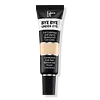What's inside
What's inside
 Key Ingredients
Key Ingredients

 Benefits
Benefits

 Concerns
Concerns

 Ingredients Side-by-side
Ingredients Side-by-side

Paraffinum Liquidum
EmollientPetrolatum
EmollientVp/Hexadecene Copolymer
Silica Dimethyl Silylate
EmollientBis-Diglyceryl Polyacyladipate-2
EmollientOzokerite
Emulsion StabilisingPhenoxyethanol
PreservativeTocopheryl Acetate
AntioxidantAluminum Hydroxide
EmollientKaolin
AbrasiveNiacinamide
SmoothingSodium Hyaluronate
HumectantMagnesium Ascorbyl Phosphate
AntioxidantAscorbyl Palmitate
AntioxidantHydrolyzed Collagen
EmollientWater
Skin ConditioningTocopherol
AntioxidantGlycerin
HumectantSteareth-20
CleansingChlorhexidine Digluconate
AntimicrobialN-Hydroxysuccinimide
Skin ConditioningSodium Citrate
BufferingPotassium Sorbate
PreservativePalmitoyl Tripeptide-1
Skin ConditioningChrysin
Skin ConditioningPalmitoyl Tetrapeptide-7
Skin ConditioningCitric Acid
BufferingBiotin
AntiseborrhoeicParaffinum Liquidum, Petrolatum, Vp/Hexadecene Copolymer, Silica Dimethyl Silylate, Bis-Diglyceryl Polyacyladipate-2, Ozokerite, Phenoxyethanol, Tocopheryl Acetate, Aluminum Hydroxide, Kaolin, Niacinamide, Sodium Hyaluronate, Magnesium Ascorbyl Phosphate, Ascorbyl Palmitate, Hydrolyzed Collagen, Water, Tocopherol, Glycerin, Steareth-20, Chlorhexidine Digluconate, N-Hydroxysuccinimide, Sodium Citrate, Potassium Sorbate, Palmitoyl Tripeptide-1, Chrysin, Palmitoyl Tetrapeptide-7, Citric Acid, Biotin
Water
Skin ConditioningCyclopentasiloxane
EmollientGlycerin
HumectantKaolin
AbrasiveDimethicone
EmollientBoron Nitride
AbsorbentTribehenin
EmollientPEG/PPG-18/18 Dimethicone
EmulsifyingTrimethylsiloxysilicate
EmollientMethyl Methacrylate Crosspolymer
Cetyl PEG/PPG-10/1 Dimethicone
EmulsifyingPEG-10 Dimethicone
Skin ConditioningHydrolyzed Vegetable Protein
Skin ConditioningPolyethylene
AbrasiveAloe Barbadensis Leaf
MaskingAloe Barbadensis Leaf Juice
Skin ConditioningMaris Sal
Skin ConditioningSilica
Abrasive1,2-Hexanediol
Skin ConditioningAlpha-Glucan Oligosaccharide
CleansingCaprylyl Glycol
EmollientLactobacillus
Skin ConditioningMaltodextrin
AbsorbentPerlite
AbsorbentPolyisobutene
Polymnia Sonchifolia Root Juice
Skin ConditioningTetrasodium EDTA
Tocopheryl Acetate
AntioxidantTriethoxycaprylylsilane
Trisiloxane
Skin ConditioningPhenoxyethanol
PreservativeCI 77491
Cosmetic ColorantCI 77492
Cosmetic ColorantCI 77499
Cosmetic ColorantCI 77891
Cosmetic ColorantZinc Oxide
Cosmetic ColorantWater, Cyclopentasiloxane, Glycerin, Kaolin, Dimethicone, Boron Nitride, Tribehenin, PEG/PPG-18/18 Dimethicone, Trimethylsiloxysilicate, Methyl Methacrylate Crosspolymer, Cetyl PEG/PPG-10/1 Dimethicone, PEG-10 Dimethicone, Hydrolyzed Vegetable Protein, Polyethylene, Aloe Barbadensis Leaf, Aloe Barbadensis Leaf Juice, Maris Sal, Silica, 1,2-Hexanediol, Alpha-Glucan Oligosaccharide, Caprylyl Glycol, Lactobacillus, Maltodextrin, Perlite, Polyisobutene, Polymnia Sonchifolia Root Juice, Tetrasodium EDTA, Tocopheryl Acetate, Triethoxycaprylylsilane, Trisiloxane, Phenoxyethanol, CI 77491, CI 77492, CI 77499, CI 77891, Zinc Oxide
 Reviews
Reviews

Ingredients Explained
These ingredients are found in both products.
Ingredients higher up in an ingredient list are typically present in a larger amount.
Glycerin is already naturally found in your skin. It helps moisturize and protect your skin.
A study from 2016 found glycerin to be more effective as a humectant than AHAs and hyaluronic acid.
As a humectant, it helps the skin stay hydrated by pulling moisture to your skin. The low molecular weight of glycerin allows it to pull moisture into the deeper layers of your skin.
Hydrated skin improves your skin barrier; Your skin barrier helps protect against irritants and bacteria.
Glycerin has also been found to have antimicrobial and antiviral properties. Due to these properties, glycerin is often used in wound and burn treatments.
In cosmetics, glycerin is usually derived from plants such as soybean or palm. However, it can also be sourced from animals, such as tallow or animal fat.
This ingredient is organic, colorless, odorless, and non-toxic.
Glycerin is the name for this ingredient in American English. British English uses Glycerol/Glycerine.
Learn more about GlycerinKaolin is a clay. It is used for oil control and to help minimize pores. Like other clays, kaolin has the ability to absorb excess sebum or oil. This can help clean out pores and mattify the skin.
Some types of kaolin may have exfoliating properties. When water is added to kaolin, it becomes a paste with small abrasive particles.
Most kaolin is a white color, but may be pink/orange/red depending on where it comes from.
The name 'kaolin' comes from a Chinese village named 'Gaoling'. Kaolin clay comes from rocks rich in kaolinite. Kaolinite, the mineral, has a silicate layered structure. Kaolinite is formed from chemical weathering of aluminum siilicate minerals.
Besides skincare, kaolin is commonly used to make glossy paper, in ceramics, toothpaste, and as medicine to soothe stomach issues.
Learn more about KaolinPhenoxyethanol is a preservative that has germicide, antimicrobial, and aromatic properties. Studies show that phenoxyethanol can prevent microbial growth. By itself, it has a scent that is similar to that of a rose.
It's often used in formulations along with Caprylyl Glycol to preserve the shelf life of products.
Tocopheryl Acetate is AKA Vitamin E. It is an antioxidant and protects your skin from free radicals. Free radicals damage the skin by breaking down collagen.
One study found using Tocopheryl Acetate with Vitamin C decreased the number of sunburned cells.
Tocopheryl Acetate is commonly found in both skincare and dietary supplements.
Learn more about Tocopheryl AcetateWater. It's the most common cosmetic ingredient of all. You'll usually see it at the top of ingredient lists, meaning that it makes up the largest part of the product.
So why is it so popular? Water most often acts as a solvent - this means that it helps dissolve other ingredients into the formulation.
You'll also recognize water as that liquid we all need to stay alive. If you see this, drink a glass of water. Stay hydrated!
Learn more about Water